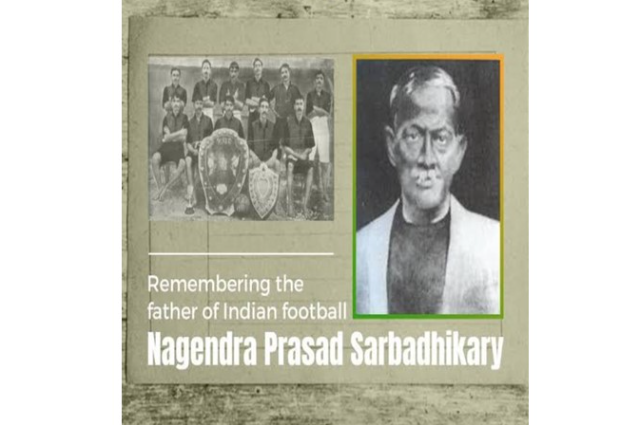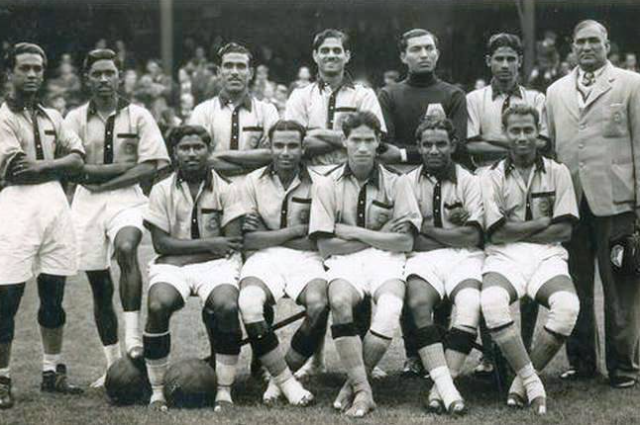
Introduction:
Despite being the second-largest populated country in the world, the quality of Indian football on the basis of performance in the international arena is too wretched to describe. When very small European nations having the population less than that of an Indian state and African or South American countries afflicted with extreme poverty, civil wars, political disturbance, disintegration, etc are exhibiting remarkable progress in football, India with its nearly 1300 million population, a progressive economy and a strong democracy is lagging behind despondently.
Glorious Past:
If we mull over the past of Indian football, we will find enough reason to boast of our rich football heritage that can be compared with that of England. Indifferent attitude towards the game pushed India far behind, whereas, England and other European countries and later Latin American and African countries embraced football as the most favourite outdoor game. The introduction of Indian football dates back to the second half of the 19th century and the first football club was established in India during the 1870s. Very few countries in the world have such a hoary tradition of more than one hundred fifty years of this game. Indian Football Team ranking was 9th in FIFA World Rankings in 1957.
Nagendra Prasad Sarbadhikari - Father of Indian Football:

Nagendra Prasad Sarbadhikari, a student of Hare School in Kolkata, erstwhile Calcutta, is justifiably attributed with the credit of starting football in Calcutta, the Capital of Indian Football. In late 1877, a ten-year old boy accompanying his mother to the river Ganges was enchanted by the sight of some British soldiers kicking and running after a spherical object at the Calcutta F. C. Ground. The boy was enthralled with the sight to watch the game. Once the ball reached near the boy who kicked it back and the ball rolled towards the soldier who dictated him to do so. The very next day he collected subscriptions and purchased a ball from Messrs Manton & Co and encouraged his classmates at the Hare School to play the game without having any knowledge of the rules. However, an ample number of people were attracted to the game of the motley group of players. Their love for the game prompted some European teachers to train and teach them about the game of football. The boy was none other than legendary figure Nagendra Prasad Sarbadhikari who is considered the first Indian to kick a football. He is also considered to be the “Father of Indian Football”. Later Mr. Sarbadhikari formed a number of football clubs in Calcutta and played an important role in the formation of IFA (Indian Football Association) in 1893.
Major Old Clubs in Indian Football:
Besides Calcutta FC, the first football club established in 1872, there were other near-contemporary clubs including Dalhousie Club, Traders Club and Naval Volunteers Club. Mohun Bagan Sporting Club now known as Mohun Bagan A.C. which is considered the oldest Indian football club, was established in 1889. It was under the rule of the army and both Hindu and Muslim players played here. Besides, a number of football clubs including Aryan Club, Cooch Behar Club etc. were founded during the end of the 19th century. However, Kerala, another football loving province, did not lag behind. R B Ferguson Football Club, the eponym of Kochi Police Super, was established in 1899 in Thrissur. Needless to say, the club played a significant role in promoting football in Kerala.
The Two Oldest Indian Football Tournaments:

Mortimer Durand, the then Indian Foreign Secretary, founded the Durand Cup at Shimla in 1888. It was one of the world’s oldest football competitions followed by the F.A Cup and the Scottish Cup. It was initiated mainly as an Army cup participated exclusively by British Indian Army personnel for recreation, stimulating sports competition in the country and maintaining health. The first edition of the cup was won by Royal Scots Fusiliers defeating Highland Light Infantry by 2-1 in the final. Later it was opened up to civilian football teams for gaining popularity. The IFA football which was originally organized by India’s first football regulatory organization was the fourth oldest football cup in the world. It was established five years after the Durand Cup in 1893 when Calcutta was not only the capital of British India but also the hub of Indian football. In this football tournament Indian footballers first got the opportunity to exhibit their excellence in football with their English counterparts. In 1911, Mohun Bagan created history by defeating East Yorkshire Regiment by 2-1 in the IFA Shield final. The victory was beyond the boundary of the football ground. It seemed to have an allegorical significance of a major political victory against the oppressive British rulers’ perfidious intrigues to partition Bengal in 1905. The victory established that the ruled could compete with the rulers and Bengal was the epicentre of Indian football.
Indian National Team:

Source: themohunbaganac.com/gostha-paul/
Gostha Behari Pal nicknamed as “Chiner Prachir” (The Wall of China) was the first captain of the Indian National Team from the 1920s to the 1930s. He was one of the best defenders of contemporary football. The first official tour of the Indian team in Sri Lanka in 1924 comprised both Indian and British players under Mr. Pal’s captaincy in Sri Lanka. But during the late 1930s Indian National Team consisted entirely of Indian players. They toured Australia, Japan, Indonesia and Thailand. In 1933, India played overseas against Ceylon and won the match by 1-0. India-China match in 1936 ended in a 1-1 draw. Several Indian football clubs performed well abroad. In 1937, India, invited by the Australian Football Association played 17 matches from August to October against many states, districts, clubs and 5 friendly matches against the Australian National Team. India’s defeat to Australia by 5-3 at Sydney on 3rd September, 1937 is India’s first FIFA-recognized match. The second match at Brisbane ended in a draw in 4-4. India won the third match by a margin of 4-1 and the last two matches were won by the Australia team. Indian striker Lmsden made a hat-trick against Australia.
Indian Football in Olympics:
London Summer Olympics Game, 1948: The Indian football team took part in four Olympics. They were the London Olympics in 1948, Helsinki in 1952, Melbourne in 1956 and Rome in 1960 respectively. The Indian National team in the 1948 Summer Olympic Games hosted by London comprised Coach Balaidas Chatterjee, Captain Talimeren Ao and other great players including S Raman, Sailen Manna, Dhanraj Mahabir Prasad, S.A. Baseer, S. Nandi, K.V.Varadaraj, Varghese Papen et al. In its international football debut at the London Games in 1948, India played their first-ever international match against France witnessed by 17,000 spectators. India lost the match 2-1. Most of the Indian players opted to play without shoes and instead wore bandages to protect their feet. In the 30th minute of the game Rene Courbin gave France a 1-0 lead. Just before the half-time, Sailen Manna missed a penalty. But in the 70th minute of the second half, Sarangapani Raman scored the equaliser. Raman was named as the first Indian to score a goal in an International match. India missed another penalty opportunity when Mahabir Prasad’s shot was saved by the French goalkeeper Guy Rouxel. Just one minute before the final whistle, Rene Persillon scored the winning goal to give France a 2-1 victory and reach the quarterfinals. But the Indians were the toast of the world as eight players played barefoot. In a press conference after the match the talismanic Indian captain Talimeren Ao in answer of the question of playing barefoot said,
“Well, you see, we play football in India, whereas you play bootball.”The historic comment was the headlines of London’s newspapers.
- 1952 Helsinki Olympics: However in the 1952 Helsinki Olympics Indian football showed the most disappointing performance. The Indian team under the captainship of legendary footballer Sailen Manna faced the biggest defeat in an international football match. The eventual silver medallist team Yugoslavia vanquished India by 10-1. The Yugoslavian striker Branko Zebec scored four goals alone whereas Ahmed Khan scored the lone goal for the Indian side in the 89th minute of the match.
- 1956 Olympics in Melbourne: But India’s performance in the Melbourne Olympics is written in golden letters in the history of the country’s football. Under the leadership of Samar Banerjee and the country’s most successful coach Syed Abdul Rahim, India created the record of reaching the semi-finals as the first Asian team in Olympic history. India after receiving a walkover as Hungary did not play, defeated hosts Australia 4-2. Neville D’Souza scored a hat-trick and the fourth goal was scored by J. Krishnaswamy and Bruce Morrow scored both the goals for Australia. D’Souza’s hat-trick was the first scored by an Asian in Olympic history. But again India failed to cut the Gordian knot of winning against Yugoslavia that reached the final defeating India by 4-1. Though D’souza scored the opening goal for the Indian side at the 52nd minute, Yugoslavia volleyed three goals within 11 minutes. For the third position and bronze medal match India was crushed by Bulgaria by a score of 3-0. Neville D’Souza of the Indian team along with Todor Veselinovic of Yugoslavia and Dimitar Stoyanov of Bulgaria was declared joint top scorers in the edition of the Games.
- Rome Olympics, 1960: Indian football team led by legendary PK Banerjee and coached by Syed Abdul Rahim made its last appearance in Rome Olympics in 1960. As the group system had already been introduced, India fell into a strong group with Hungary, Peru and France. After giving a tough fight India was defeated 2-1 to Hungary, the eventual bronze medallist in the tournament. Despite the Hungarians seemingly cruising in the match, Indians staged a comeback when Tulsidas Balram enkindled hope after scoring a goal in the 79th minute of the match. But it was too late to equalize the match. In the second match in the group PK Banerjee’s goal in the 71st minute helped India hold France to a draw. In the last match in the group against Peru, India was cast out of the tournament facing a defeat of 3-1. The lone goal for India was scored by Tulsidas Balram. Thus the Olympic journey of the Indian football team ended.
India in FIFA World Cup:
India qualified for the World Cup hosted by Brazil in 1950. But the team withdrew itself for want of funds in getting the team to Brazil. But another reason is also cited. India withdrew from the World Cup due to FIFA imposing a rule banning players to play in the tournament barefoot. However, Sailen Manna, the then captain of India, ruled out the barefoot theory. According to him it was just an excuse to cover up the real reasons as the AIFF decided not to travel to Brazil. From then on India has never qualified in the final round of FIFA World Cup.
India in Asian Games:
India participated in eleven Asian Games from 1951 to 1998 except 1990 and 1994 editions. India won the first Asiad football defeating Indonesia in the first round, Japan in the semi-final and Iran in the final. Thus India became the first ever Asian Games gold medallist and the first ever Asian football champions as well. In the next couple of tournaments India did not fare well. But India resurrected in 1962 and won the Asian Gold medal after beating Asian giant South Korea. India finished runners up in the 1964 Asian Games. Chuni Goswami became the Blue Tigers skipper in the tournament. In 1970, India grabbed the bronze medal.
The Troika and Other Indian Footballers:

Indian football reached its zenith during the period from 1948 to 1964. India played four Olympics, qualified for the final round of FIFA World cup and won two Asian Games gold medals. Though football is a team game, the three players who spearheaded to architect the Golden period of Indian football were PK Banerjee, Tuslsidas Balaram and Chuni Goswami. PK Banerjee who played mainly as right-winger had the capacity to drift any attacking position and score from any angle. His special quality was a tremendous burst of speed. He was a good header as well as a passer. Subimal Goswami popularly known as Chuni Goswami became the poster boy of Indian football for his qualities of dribbling, passing and ball possession. Tulsidas Balram was popular for attacking football. He had the unique ability to collect and dribble the ball. Besides, Peter Thangaraj, Jarnail Singh, Sailen Manna, Ram Bahadur, Yusuf Khan, Neville D’Souza et al deserve special mention for their contribution to elevating Indian football to an Icarus height.
Conclusion:
Ironically, India which had once prevailed over Australia, Japan, South Korea and Iran in 1950s and 1960s, are now languishing in the 104th position out of nearly 200 football playing countries in the world in the FIFA ranking. Football in our country is now vacillating between amateurism and professionalism. Ace Indian footballer Bhaichung Bhutia appropriately lamented that Indian football was what it was 100 years ago. It is not enough to appoint foreign coaches for the improvement of Indian football. The All India Football Federation (AIFF) should lay emphasis on indigenous talents by setting up football academies where promising players of young ages can be groomed professionally. The players should be provided adequate exposure and modern facilities for physical, mental and psychological developments. Above all, the future of the footballers should be secured materially. Last but not the least; a healthy football milieu tinted with the memories of golden days of Indian football needs to be created.
. . .
References:
- “Football looks to score in India” by Bill Wilson (BBC News)
- “History of Football in India”; iloveindia.com
- “Nagendra Prasad Sarbadhikari, known as the father of Indian football”; All India Football Federation
- “The Golden Years of Indian Football: Chase Your Sports” (Sports Social Blog)
- “Indian Football Team Made First Olympics Appearance In?” Olympics FAQs Answered by Arnold Dsouza
- “PK, Chuni, Balaram, the troika that scripted Indian football’s Golden Era” by Utathya Nag
- “Mohun Bagan and the fight for Indian independence” by Conor Heffernan

